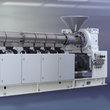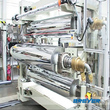|
|








|
 |
Linie ekstruzji BREYER – wyprodukowane w Niemczech.
Jakościowe linie ekstruzji dla przemysłu przetwórstwa tworzyw sztucznych. |
Rodzaj działalności : |
Manufacturer |
 EVA Film line for PV-encapsulation film EVA Film line for PV-encapsulation film
High-performance Extrusion lines for encapsulation film
High-performance Extrusion lines for encapsulation film
At the production of PV Solar panels, EVA film is used for encapsulation of cells.
In order to process this EVA film, special properties have to be fulfilled, e.g. low shrinkage or better no shrinkage.
This is a real challenge for the extrusion process. Standard extrusion lines only allow a very low processing speed. At speed over 5m/min a high shrinkage of the film can occur so that a further processing of this film is no longer possible.
Reason
Since the regular extrusion system is limited to a certain speed/output, Breyer developed a profitable system for the production of EVA film and other gluey materials.
The system allows much higher speed and therefore higher output compared with typical extrusion systems.
The process allows an almost shrinkage-free production of solarfilm at high speed!!! Especially gluey materials like EVA can be processed easier on this system compared with a calender/cast film unit.
Patents/publications  Automatic extrusion die Article Automatic extrusion die Article
Automatic extrusion die Article For the first time a drastic reduction of the start-up time for the film production could be achieved with a Breyer die.
Automatic extrusion die Article For the first time a drastic reduction of the start-up time for the film production could be achieved with a Breyer die. Compared to conventional automatic dies, the film thickness within the specific tolerance range can now be adjusted much faster and with a high degree of repetitiveness. Reason In combination with a Breyer calender a 200 µm ... more Automatic extrusion die
For the first time a drastic reduction of the start-up time for the film production could be achieved with a Breyer die. Compared to conventional automatic dies, the film thickness within the specific tolerance range can now be adjusted much faster and with a high degree of repetitiveness. Reason
In combination with a Breyer calender a 200 µm both side polished film with at thickness tolerance of 2-3 µm was set up in less than 15 minutes. In comparison to the former automatic control this means a reduction of over 75%!
Linie ekstruzji BREYER – wyprodukowane w Niemczech.
Jakościowe linie ekstruzji dla przemysłu przetwórstwa tworzyw sztucznych.
Na następnych stronach informujemy Państwa o naszej historii i filozofii. Jeśli chcielibyście Państwo odwiedzić naszą firmę, znajdziecie dalsze informacje w sekcji lokalizacja z bezpośrednim linkiem do mapy trasy.
Doświadczenie zawsze było uważane za klucz do sukcesu.
Dotyczy to głównie przemysłu przetwórstwa tworzyw sztucznych z jego ciągle zmieniającymi się wymaganiami i nowymi zadaniami. Wiedza ekspercka i podejście do rozwiązań w bardzo nietypowy sposób uczyniły nas tym, kim jesteśmy dziś: pionierem i prekursorem na wielu rynkach. Ponieważ od początku nigdy nie ograniczaliśmy się do konkretnego segmentu i zawsze dążyliśmy do przekształcenia czegoś dobrego w coś jeszcze lepszego: Linie ekstruzji od planowania, przez produkcję, aż po instalację u klienta. Od ponad 60 lat.
View our presentation for Extrusion lines for the plastic processing industry

|

| Ekstrudery Od początku do przodu. Jednym z kluczowych elementów każdego systemu ekstruzji jest i pozostaje sam ekstruder. Prawie od początku nacisk w BREYER kładziony jest na jakość i zaawansowaną technologię. Specjalizowany projekt śruby jest doskonałym przykładem, ponieważ oferuje znacznie większe pojemności wyjściowe niż konwencjonalne projekty. Do tego dodaliśmy specjalną strefę wentylacyjną. | 
| Kalendarze Technologia systemu kalendarza BREYER, wyprodukowana w Niemczech. BREYER oferuje szeroką gamę systemów kalendarzowych, każdy doskonale dostosowany do procesu produkcyjnego. Poziome, pionowe i skośne średnice kalendarza od 300 do 600 mm (modele wykonane według specyfikacji na życzenie), grubość kalendarza od 600 do 3000 mm.
| |
|
|

